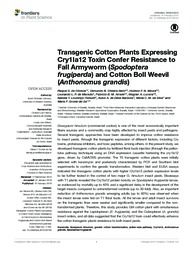Transgenic cotton plants expressing Cry1la12 toxin confer resistance to fall armyworm (Spodoptera frugiperda) and cotton boll weevil (Anthonomus grandis).
Transgenic cotton plants expressing Cry1la12 toxin confer resistance to fall armyworm (Spodoptera frugiperda) and cotton boll weevil (Anthonomus grandis).
Author(s): OLIVEIRA, R. S. de; OLIVEIRA NETO, O. B.; MOURA, H. F. N.; MACEDO, L. L. P. de; ARRAES, F. B M.; LUCENA, W. A.; LOURENCO, I. T.; BARBOSA, A. de D.; SILVA, M. C. M. da; SA, M. F. G. de
Summary: Gossypium hirsutum (commercial cooton) is one of the most economically important fibers sources and a commodity crop highly affected by insect pests and pathogens. Several transgenic approaches have been developed to improve cotton resistance to insect pests, through the transgenic expression of different factors, including Cry toxins, proteinase inhibitors, and toxic peptides, among others. In the present study, we developed transgenic cotton plants by fertilized floral buds injection (through the pollen-tube pathway technique) using an DNA expression cassette harboring the cry1Ia12 gene, driven by CaMV35S promoter.
Publication year: 2016
Types of publication: Journal article
Unit: Embrapa Cotton
Observation
Some of Embrapa's publications are published as ePub files. To read them, use or download one of the following free software options to your computer or mobile device. Android: Google Play Books; IOS: iBooks; Windows and Linux: Calibre.
Access other publications
Access the Agricultural Research Database (BDPA) to consult Embrapa's full library collection and records.
Visit Embrapa Bookstore to purchase books and other publications sold by Embrapa.

